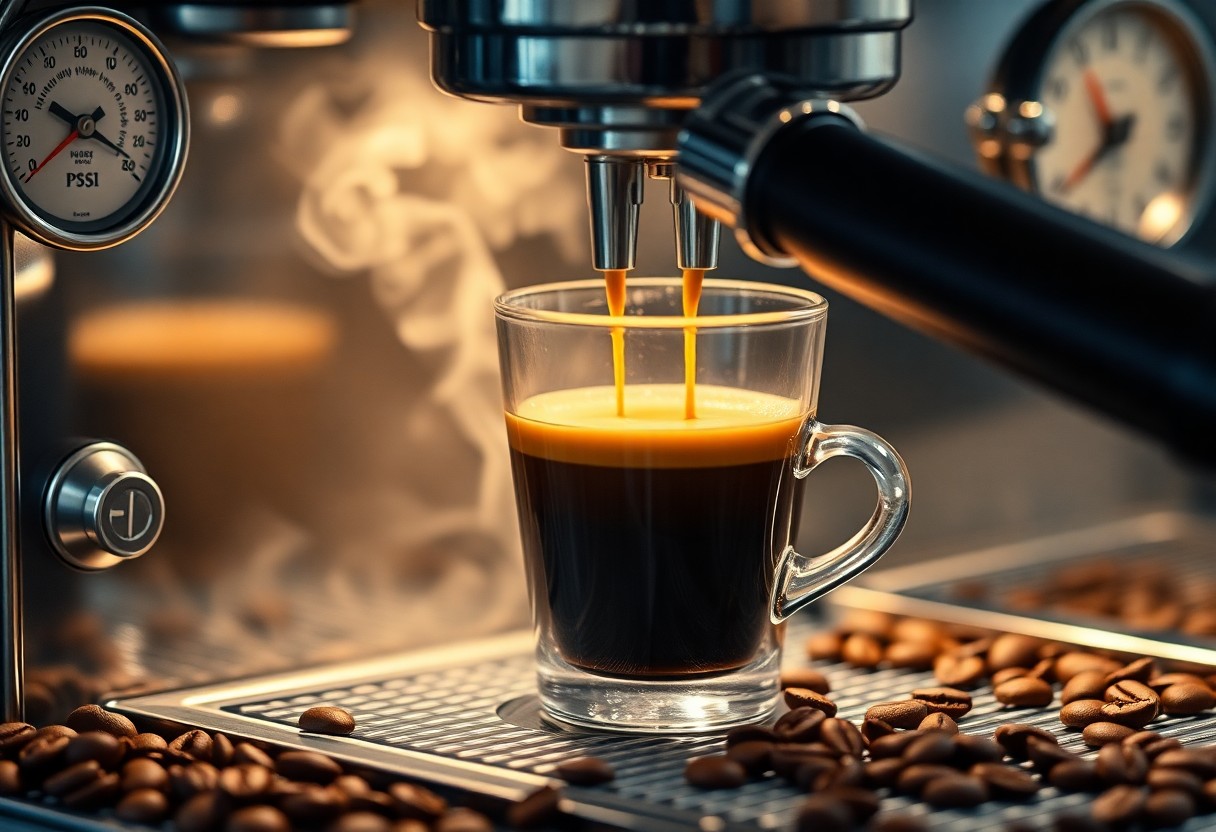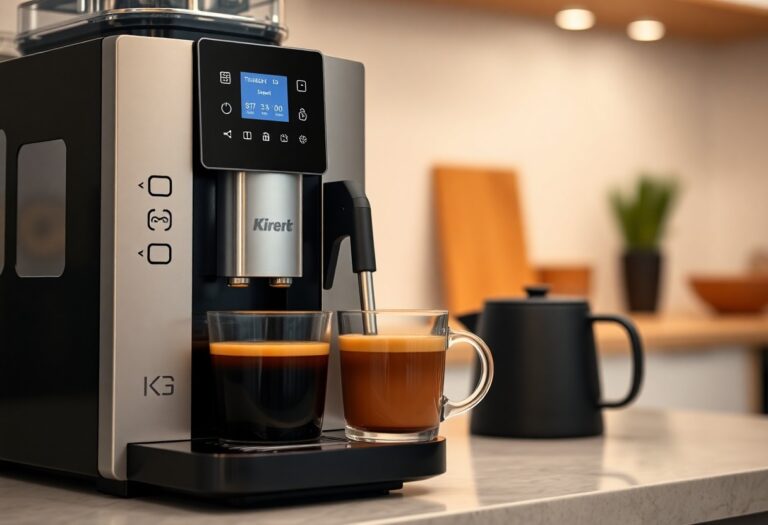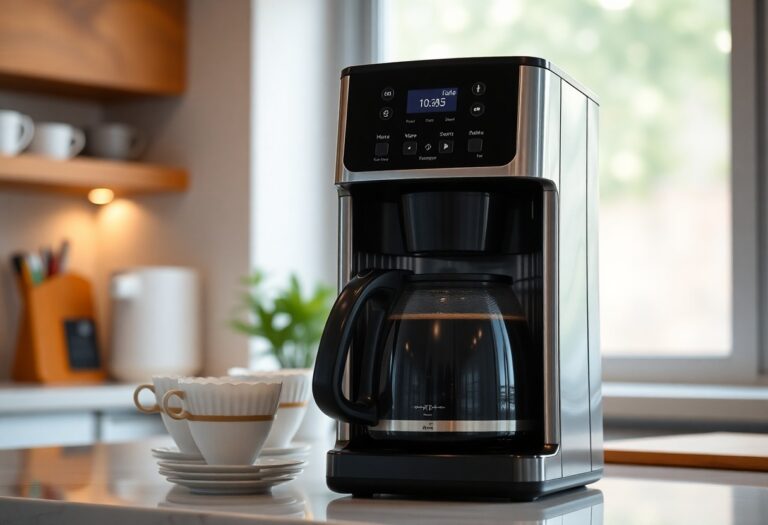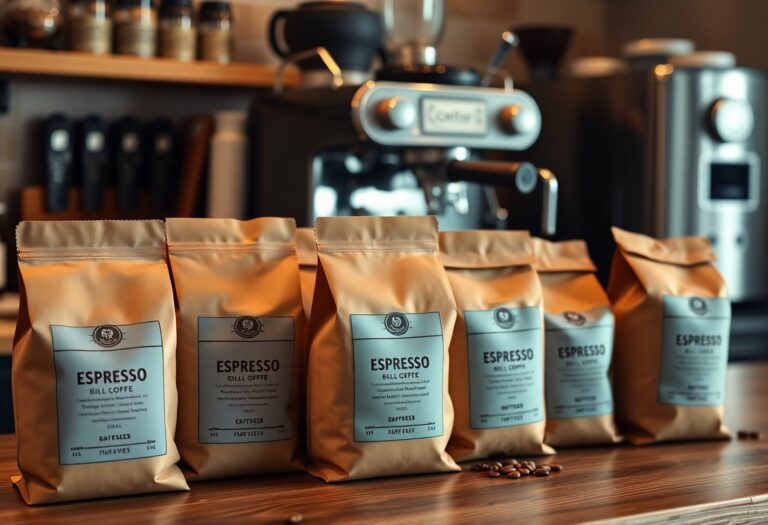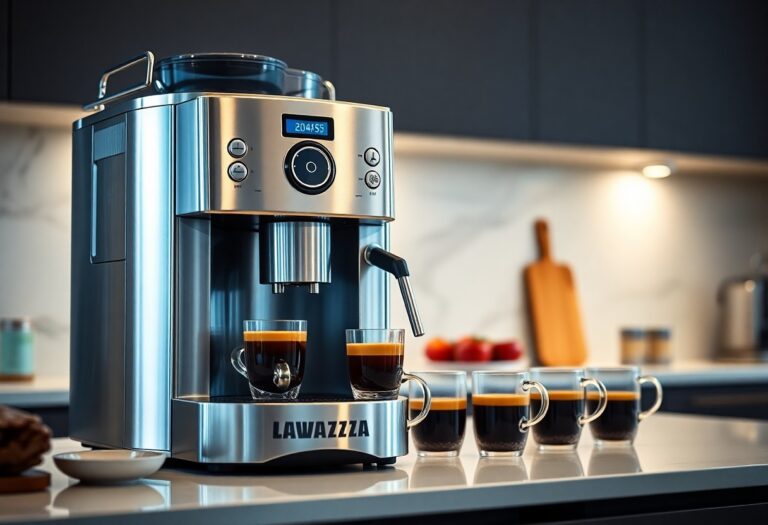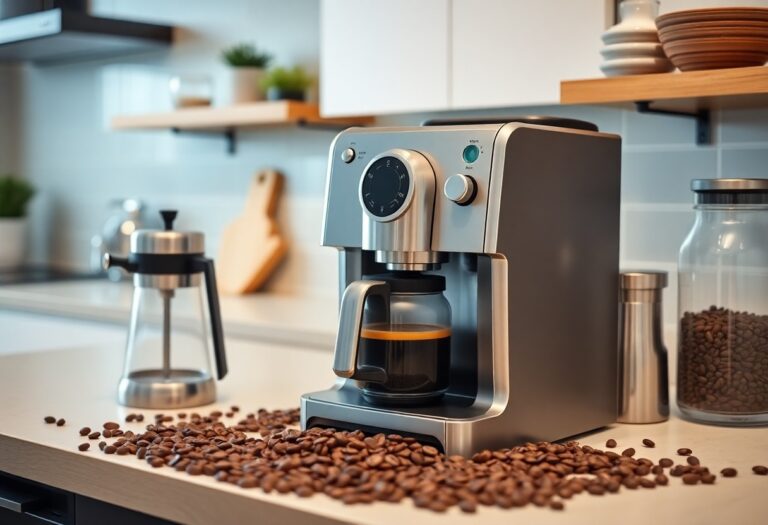What is an Espresso Coffee Machine – High-Pressure Brewing
The Craft Behind High-Pressure Brewing
High-pressure brewing is the alchemy that transforms humble coffee grounds into a harmonious espresso shot. By pushing hot water through coffee at pressures typically around 9 bars, you unlock complex flavors and create a rich, velvety crema. This process requires meticulous calibration, as even a slight variation in pressure can alter the extraction balance, leading to a bitter or sour taste. Great baristas often speak of the art of “dialing in” the perfect shot, experimenting with grind size, tamping force, and brew time to achieve that sweet spot where flavor profiles are at their peak.
Key Takeaways:
- Espresso coffee machines operate by forcing hot water through finely-ground coffee at high pressure, typically around 9 bars.
- The brewing process extracts rich flavors and aromas, resulting in a concentrated coffee shot with a creamy layer of crema on top.
- Different types of espresso machines are available, including manual, semi-automatic, automatic, and super-automatic, catering to varying skill levels and preferences.
- Maintaining appropriate grind size and coffee dose is crucial for optimal espresso extraction, impacting taste and quality.
- High-pressure brewing not only enhances flavor but also plays a role in the extraction time, usually taking 25 to 30 seconds for the perfect shot.
Essential Components of an Espresso Machine
Understanding the components of an espresso machine is vital to appreciate how these machines deliver that perfect shot of espresso. An espresso machine comprises several elements that work together to create the high-pressure extraction process. Key components include the pump, boiler, portafilter, group head, and steam wand. For more detailed insights, check out Brew pressure and its effects on espresso.
The Role of the Pump: Powering Precision
Your espresso machine’s pump is important for generating the high pressure needed for brewing. Typically, commercial machines use rotary pumps, delivering consistent pressure regardless of water flow. In contrast, vibratory pumps are more common in home machines, providing sufficient pressure but varying with suction. The pump’s efficiency can greatly affect your espresso quality, emphasizing why a reliable pump is critical for passionate baristas.
Boiler Types: Maintaining Optimal Temperature
Temperature management in espresso brewing directly affects flavor extraction. Machines typically feature either single, double, or heat exchanger boilers. Single boilers can brew and steam but require time to switch functions, while double boilers allow simultaneous brewing and steaming, ensuring precision. Heat exchanger boilers maintain high efficiency but may require more maintenance. Having good temperature control ensures a rich and balanced espresso shot.
| Boiler Type | Description |
| Single Boiler | Can brew and steam but requires time to switch. |
| Double Boiler | Brews and steams simultaneously for better control. |
| Heat Exchanger | Makes steaming and brewing efficient but requires care. |
| Thermal Carafe | Maintains temperature without a heating element. |
- Brewing efficiency ensures quality.
- Temperature stability preserves flavor integrity.
- Maintenance ease keeps functionality.
- Simultaneous steaming enhances productivity.
- Any espresso enthusiast knows that understanding these boiler types is vital.
Brewing Techniques That Matter
Mastering brewing techniques is key to unlocking the full potential of your espresso coffee machine. Variables such as water temperature, brew time, and pressure can deeply influence your espresso’s flavor profile. Engaging with these techniques enables you to tailor your coffee drinks, adjusting each variable to create the perfect cup that suits your palate and preferences.
The Science of Extraction: What Really Happens
Extraction is the process where water interacts with coffee grounds, drawing out flavors, oils, and nutrients. During this process, different compounds dissolve at varying rates, depending on factors like temperature, pressure, and time. Understanding this intricate balance helps you manipulate the extraction process, ensuring optimal flavor development in your espresso.
Dose and Grind Size: Key Variables for Flavor
The amount of coffee used, referred to as dose, along with the grind size, directly affects your espresso’s flavor complexity. A finer grind increases the surface area, facilitating quicker extraction, while a coarser grind slows it down. Finding the right balance can result in an espresso that’s well-rounded and aromatic, while deviations may lead to over-extraction or under-extraction, affecting the quality of your cup.
Typically, a standard dose for a single shot of espresso ranges from 7 to 10 grams, while double shots use about 14 to 18 grams. For grind size, you want something akin to table salt for optimal extraction. You can experiment with varying doses and grind sizes to discover your desired taste. A finer grind extracted with a higher dose may yield a rich, bold espresso; conversely, a coarser grind may produce a clean and bright flavor profile. Adjusting these aspects allows you to fine-tune your brew, guiding you closer to your ideal espresso experience.
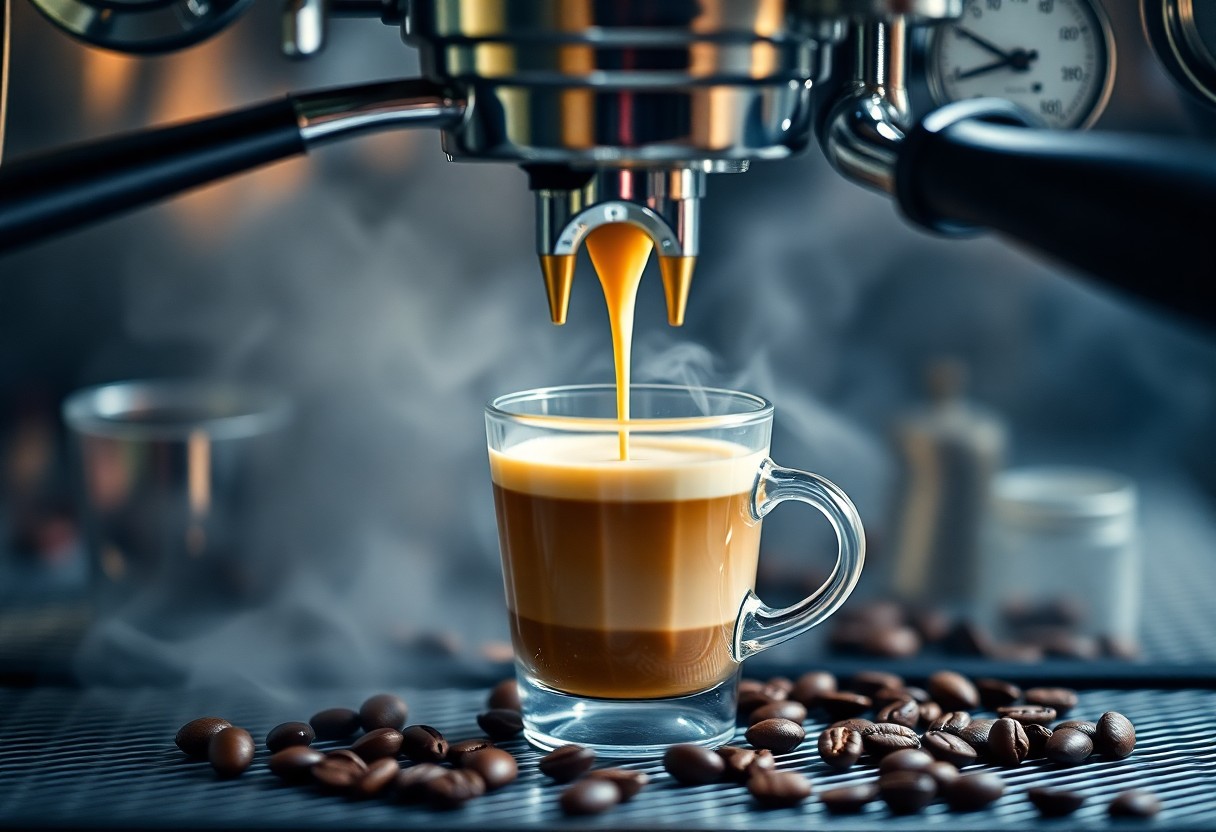
The Impact of Pressure on Flavor Profiles
The brewing process under high pressure is what distinguishes espresso from other coffee methods. This pressure extraction allows for a more intense flavor, richer body, and a formidable aroma, all of which are vital for creating that signature espresso experience. By forcing hot water through the coffee grounds at around 9 bars of pressure, the soluble compounds in the coffee beans are extracted in a short time, resulting in a concentrated shot that showcases the bean’s unique characteristics.
How Pressure Influences Taste and Aroma
Pressure plays a vital role in shaping the taste and aroma of your espresso. Higher pressure extraction enhances the soluble oils present in the coffee, which contribute to a fuller body and a more pronounced flavor profile. Additionally, this pressure influences the extraction time, allowing for a delicate balance of acidity and sweetness, bringing out floral notes, caramel undertones, and other complex flavors your palate might enjoy.
The Balancing Act: Achieving the Perfect Crema
A rich, thick crema on your espresso is a hallmark of quality, and achieving this texture hinges significantly on the brewing pressure. Proper pressure not only extracts oils but also emulsifies them with water, creating that beautiful crema layer. Too much pressure can lead to over-extraction, resulting in a bitter taste, while too little can lead to a watery shot lacking in body and flavor. Finding that right balance is vital for an optimal espresso experience.
To achieve the perfect crema, precision is key. The ideal brewing pressure is generally accepted to be around 9 bars, allowing you to extract flavorful compounds without overwhelming the palate with bitterness. The crema should appear thick and golden, ideally lasting for several minutes on top of your shot. Experimentation with your espresso machine’s settings, coffee grind size, and tamping technique can help you refine this balance. Observing how different coffee beans respond to the pressure can also guide your choices, as various beans will perform differently under similar conditions, ultimately impacting the final cup.
Maintenance and Best Practices for Longevity
Maintaining your espresso coffee machine not only enhances its performance but also ensures the longevity of the appliance. A simple routine involving regular cleaning and preventative measures can make a significant difference. Pay attention to descaling, clean all removable components like the portafilter and group head, and always flush the system after use. Your espresso machine will reward you with consistent quality and flavor in every cup while avoiding expensive repairs.
Regular Cleaning Routines for Consistent Quality
Incorporating a regular cleaning schedule for your espresso machine is imperative for optimal performance. After every use, wipe down the exterior and clean the portafilter and basket. Dedicate a weekly routine to deep clean the machine, including backflushing with the proper cleaning detergent. Monthly descaling ensures that mineral build-up doesn’t inhibit the water flow or affect the taste of your espresso, keeping your beverage rich and flavorful.
Troubleshooting Common Espresso Machine Issues
Encountering issues with your espresso machine can be frustrating, but many problems have straightforward solutions. Common issues include inconsistent extraction, leaks, and a lack of pressure during brewing. Identifying the root cause quickly can save time and prevent further damage. Inspect seals, clean the group head, and ensure there are no blockages in the water pathways. Familiarizing yourself with your machine’s manual can also guide you through more complex troubleshooting scenarios.
For example, if you notice a drop in extraction quality, consider whether the grind size of your coffee is appropriate; it should be fine enough to allow for the required pressure but not so fine that it clogs the filter. Leaks may stem from worn gaskets; check and replace them if necessary. Regularly assess water pressure settings to avoid brewing under incorrect conditions. Many issues can often be resolved by merely resetting the machine or replacing a minor component, so don’t hesitate to consult the manual or reach out to a professional if problems persist.
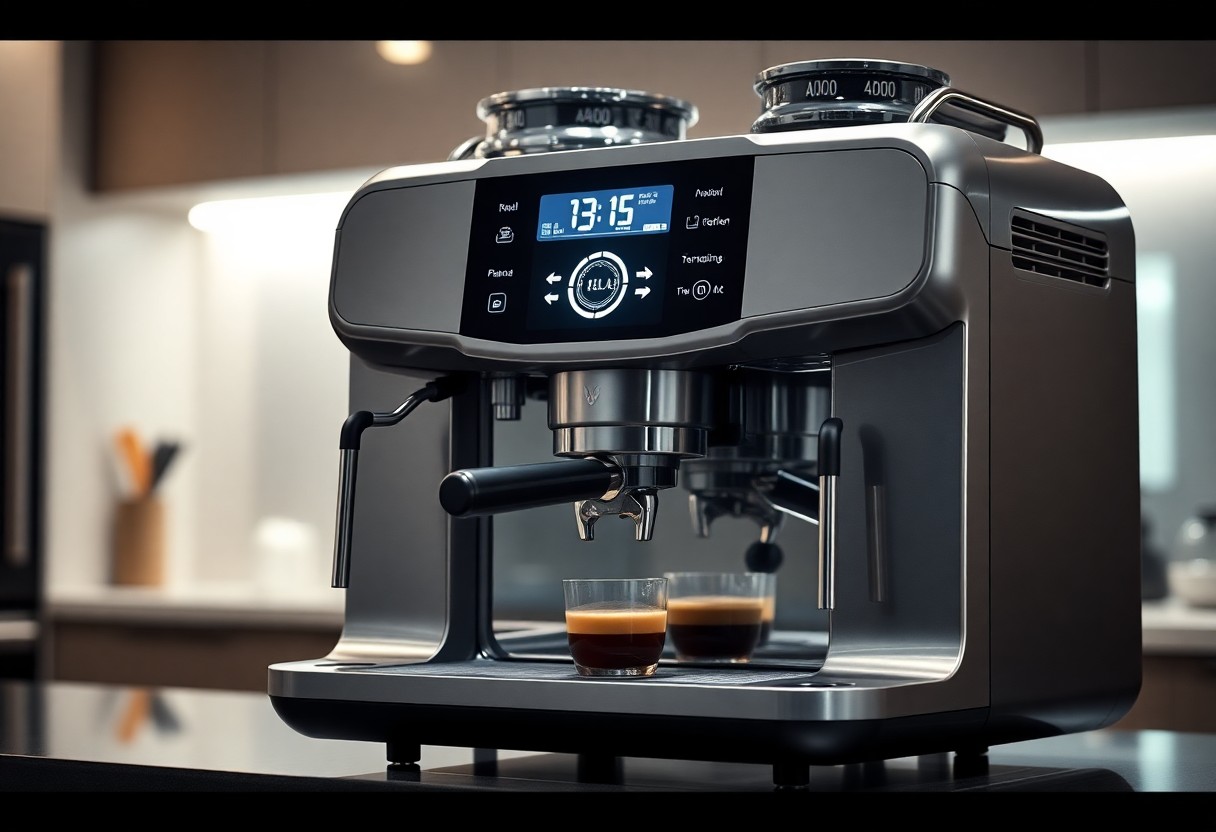
The Future of Espresso Machines: Innovations and Trends
Looking ahead, espresso machines are evolving quickly, embracing advanced technology and sustainable practices. The integration of smart features promises to transform your coffee-making experience, while eco-friendly options become increasingly prevalent. As you explore new models, you’ll find that manufacturers prioritize not only performance but also the environmental impact of their products.
Smart Technology: The New Wave of Espresso Making
Smart technology is revolutionizing how you interact with espresso machines. With smartphone connectivity, you can control your machine remotely, save personalized brewing settings, and even receive maintenance alerts. Some brands are incorporating AI to suggest optimal settings for different beans, ensuring you achieve the perfect cup every time.
Sustainability in Coffee Brewing: Eco-friendly Options
The rise of sustainability in the coffee industry has led to significant innovations in eco-friendly espresso machines. Manufacturers now focus on energy efficiency, biodegradable coffee pods, and recyclable materials. By choosing these options, you can enjoy your espresso while minimizing your environmental footprint.
When choosing an eco-friendly espresso machine, look for models that utilize energy-saving features such as programmable shut-off times and low power consumption during operation. Also, consider machines constructed from recyclable materials and those that promote the use of organic, fair-trade coffee beans. These practices not only lessen your impact on the environment but also support sustainable farming methods, providing you with a guilt-free indulgence in every cup.
Summing up
Summing up, an espresso coffee machine utilizes high-pressure brewing to extract rich flavors and create a concentrated shot of coffee that delivers a robust taste profile. By forcing hot water through finely-ground coffee at optimal pressure, you achieve the perfect espresso, including the necessary crema. Understanding your machine’s settings and experimenting with different beans can enhance your coffee experience, allowing you to customize each cup to your preference. Embracing this method elevates your home brewing and transforms your daily coffee routine into a delightful ritual.
FAQ
Q: What is an espresso coffee machine?
A: An espresso coffee machine is a specialized device designed to brew espresso by forcing hot water through finely-ground coffee at high pressure. This process extracts rich flavors and aromas, resulting in a concentrated coffee beverage known for its bold taste and creamy texture.
Q: How does high-pressure brewing work in espresso machines?
A: High-pressure brewing is achieved through a pump system within the espresso machine. Typically, a pressure of 9 to 15 bars is applied to the water, which allows it to pass through the coffee grounds quickly. This process ensures that the crucial oils, flavors, and aromas are extracted efficiently, creating a rich crema on top of the espresso.
Q: What are the key components of an espresso coffee machine?
A: The main components of an espresso coffee machine include the portafilter, boiler, pump, group head, and steam wand. The portafilter holds the coffee grounds, the boiler heats the water, the pump generates high pressure, the group head connects the portafilter to the machine, and the steam wand is used for frothing milk.
Q: Can I make other coffee beverages with an espresso machine?
A: Yes, an espresso machine can be used to create various coffee beverages beyond traditional espresso. Options include lattes, cappuccinos, macchiatos, and Americanos. With the addition of steamed milk or hot water, skilled baristas can craft a wide range of delicious drinks using espresso as the base.
Q: What types of espresso machines are available in the market?
A: There are several types of espresso machines, including manual, semi-automatic, fully automatic, and super-automatic models. Manual machines require hands-on technique, semi-automatic machines offer some automation while allowing for user control, fully automatic machines handle all brewing tasks, and super-automatic machines additionally grind beans and froth milk for convenience.

